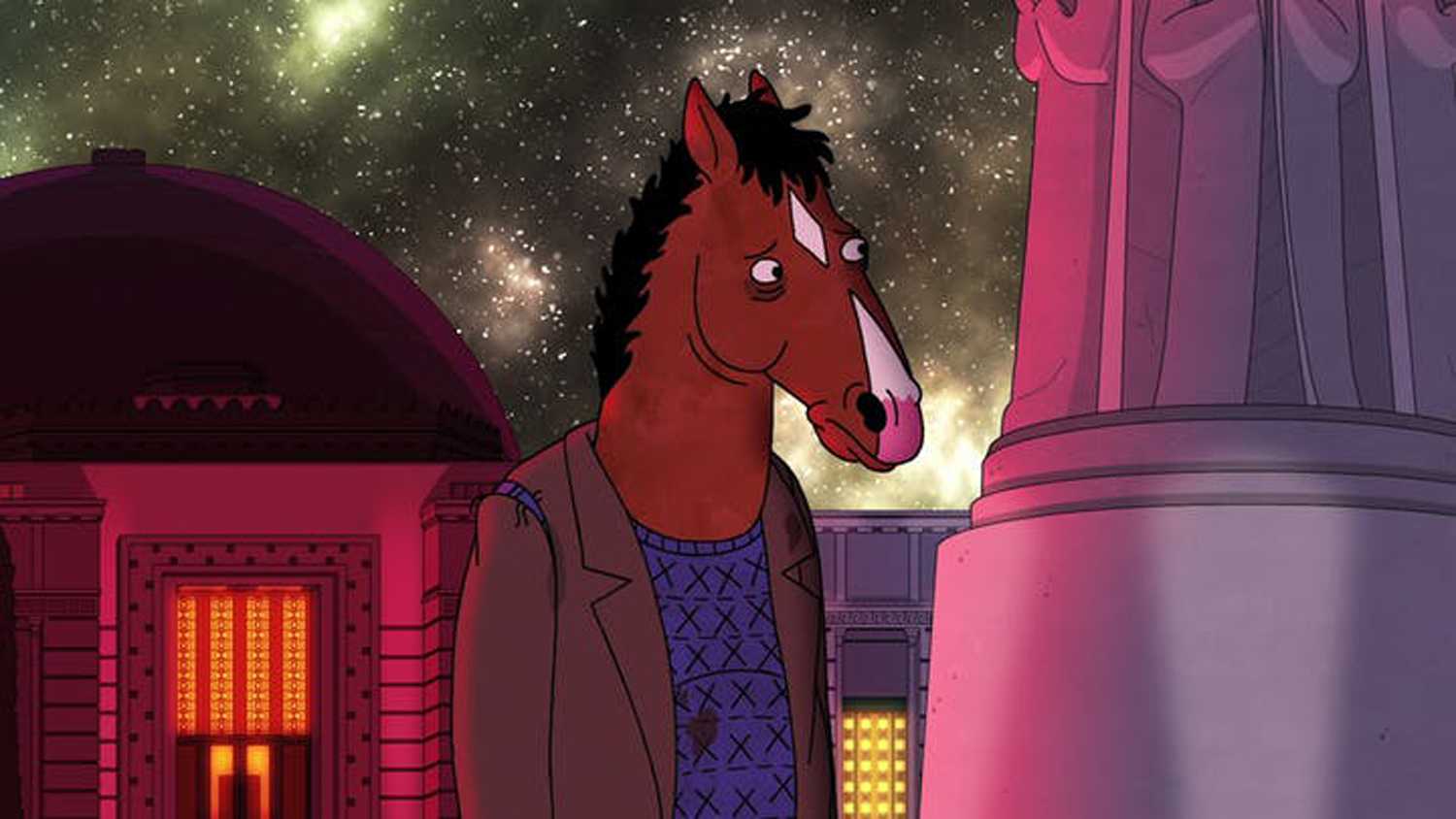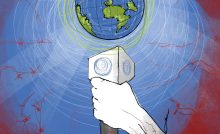Opinion | “BoJack Horseman” is as real as it gets


“BoJack Horseman” still.
If you mindlessly watched the first couple episodes of the “BoJack Horseman” series without paying too much attention, you would think it is a goofy animated sitcom — like most adult animated shows.
Netflix’s first original animated series — “BoJack Horseman” — ended on Jan. 31 after the release of the second half of its sixth season. Aptly deemed a tragicomedy, the series explores the life of a washed up anthropomorphic horse actor named BoJack Horseman.
The more the show progresses, however, it becomes evident that it is far from most adult animated shows. Real issues such as substance abuse, depression, relationships and a plethora of other hard-hitting topics are discussed throughout the six seasons of the show. By the end of the show, you won’t be wondering why you feel emotionally attached to this cartoon alcoholic horse man.
The premise of “Bojack Horseman” starts off fairly basic — back in the ’90s, BoJack was the beloved star of a famous TV show called Horsin’ Around. Upon the sitcom’s cancellation, BoJack was lost and had no life direction. Now 18 years later, BoJack is still lost and still has no life direction — drowning himself in a sea of drugs, alcohol and depression.
Much of the series is spent focusing on BoJack’s life and the relationships around him. It is hard to believe that a television show can accurately depict the issues surrounding mental health — let alone a cartoon. “BoJack Horseman” is actually the best visual representation for understanding depression and substance abuse because of its ability to interpret reality through animation.
At the end of the first episode, BoJack and his friend Diane have a conversation about the fleeting nature of happiness — foreshadowing that serious existential topics will be discussed throughout the show’s entirety. Even the show’s opening credits have a dramatic feel to them — a house perched precariously on top of a hill, BoJack lifelessly going through the motions of his daily routine, BoJack falling into a pool, seemingly content with drowning.
The first season really sets up what BH is all about — BoJack prioritizing his own happiness at the expense of ruining other people’s lives. Take Todd for example — he believes BoJack to be his best friend. If that really was the case, then BoJack wouldn’t have sabotaged a lifetime opportunity for Todd, all so BoJack could keep him in his life without confronting his fear of being alone. Though the event is dramatized in the show, deeply depressed and damaged individuals like BoJack do things like this in real life. TV shows like “13 Reasons Why” often display these troubled individuals as violent or predatory. BoJack is changing that stigma by showing that not every depressed, neurotic individual is out to intentionally harm others — some just do it because they don’t know how not to.
Also shown in season one and throughout the show are the drug binges that BoJack goes through. Perhaps one of the best aspects of the show is that the cinematography properly depicts — albeit with some dramatization — what it is like for someone on a bender. One minute BoJack is talking to Diane in California, the next minute he is blacking out and on his way to Ohio. BoJack doesn’t know how he got there, and neither does the audience — it is as if we are living vicariously through BoJack, something the show constantly tries to portray.
In season five, BoJack is addicted to opioids after a stunt goes awry. At first, BoJack seems fine or, at least, his version of fine. As each scene passes, BoJack slowly but surely goes off the deep end — he is losing his grip with reality more and more by the second. Once his pills run out, BoJack — though he may not realize it — has already developed a dependency on them. He even goes as far as to get himself into a car accident — risking his own life and the lives of other drivers — just to get more pills, which he claims he doesn’t need.
It practically goes without saying, but this is something that individuals deal with every single day. It may not be opioids, and it may not be as dramatic as a car accident, but there is an addiction problem among medical patients. Not many shows will go as far as to show the things people will do in order to get something they’re addicted to — let alone showing the complete steps those people took.
It is clear that BoJack is an unwell individual. This is not the case for every addict, but many addicts like BoJack use addiction as a way to deflect serious insecurities, mental health issues and traumatic events. In BoJack’s case, all three of these factors play a part. BoJack is a severely depressed individual that is choosing to deflect and suppress these feelings. Evidence of this is in the episode titled “Stupid Piece of Shit.” In this episode, BoJack’s inner monologue is brought to the forefront as we listen to the countless times BoJack castigates himself for his choices and actions. Specifically, there is a scene where BoJack’s sister asks him to get milk, and he instead spends the entire day at the bar. Later in the episode, BoJack throws his dementia-ridden mother’s precious doll over the side of his house out of spite because he thought she was being a better parent to the doll than she was to him.
There is no better TV episode that depicts depression than this one. Even though the show is animated, the writers present the episodes in such a way that it strikes a chord with your emotions. In this episode specifically, the relatability factor is unmatched — everyone who is depressed has felt that feeling of worthlessness as their inner monologue berates their every move. They would do anything to silence that evil voice in their head, and drinking until you black out does that perfectly.
There are other episodes like this, in which we are given a look inside the main characters’ brains. Princess Carolyn — BoJack’s feline agent who is also a single mother — is worn out from trying to do it all. In the episode “The New Client,” Princess Carolyn is seen having to anxiously juggle raising a newborn baby, running a talent agency and attempting to coordinate fundraising events all at the same time. Throughout the episode, Princess Carolyn’s thoughts are seen as colorful apparitions separating from her body, with each apparition successfully one task each — the visualization of multitasking. In reality, she forgets to accomplish many of the tasks and the ones she does accomplish are half-assed — all the while she is barely sleeping. Princess Carolyn always tries to be the perfect woman and always attempts to show no weaknesses or insecurities. In this episode she looks like a shell of herself, visibly worn out from all of the anxieties and tasks associated with being a single mother and a high-powered businesswoman.
Though it is a cartoon, make no mistake — this show is as real as it gets. Practically everyone who watches will relate to at least one subject touched upon in the show. This show is not for the faint of heart. You will cry — tears of joy and sadness — you will scream, you will laugh, you will be uncomfortable. Like life itself, you will experience a range of emotions while watching this show. This show will make you realize things about yourself that you never knew and will verbalize feelings that you couldn’t express.
To people who have not watched the show, it seems nearly impossible that a cartoon could touch on heavy topics like depression and substance abuse and still present it in a way that is clever and relatable. Seeing different situations from multiple perspectives — especially BoJack’s — makes it much more poignant than other live-action dramas. When watching “BoJack Horseman,” you truly feel like you understand the entire situation while simultaneously feeling like you need more. It walks that fine line of ambiguity and certainness, and that drives the show and makes it so enthralling.
To put it bluntly, this show just gets it. The writers know how to be relevant in today’s climate and relate to everyday people while simultaneously making the episodes so captivating that you won’t even blink.
Ethan Tessler writes about whatever he feels strongly about. Write to him at ezt2@pitt.edu or tweet at him @ethan_tessler.
Recent Posts
SGB addresses concerns about ICE presence on campus, hears SJP lawsuit against administration, approves governing code bill
At its weekly meeting on Tuesday at Nordy’s Place, Student Government Board heard concerns about…
ACLU of Pennsylvania sues Pitt over SJP suspension
The ACLU of Pennsylvania filed a federal civil lawsuit against the University of Pittsburgh and…
Marquan Pope: The ultimate shark
One of the most remarkable things about sharks is that an injury doesn’t deter them.…
Who Asked? // Do we really get a summer vacation?
This installment of Who Asked? by staff writer Brynn Murawski mourns the seemingly impossible perfect…
Notes From an Average Girl // Notes from my junior year
In this edition of Notes From an Average Girl, senior staff writer Madeline Milchman reflects…
Meaning at the Movies // The Power of the Movie Theater
In this edition of “Meaning at the Movies,” staff writer Lauren Deaton discusses her love…


